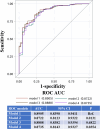Risk prediction model for difficulty in weaning from mechanical ventilation in critically ill patients: results from a multicentre retrospective study
- PMID: 40379314
- PMCID: PMC12083323
- DOI: 10.1136/bmjopen-2024-097419
Risk prediction model for difficulty in weaning from mechanical ventilation in critically ill patients: results from a multicentre retrospective study
Abstract
Objectives: We aimed to establish a diagnostic system using retrospective data to predict difficult wean from mechanical ventilation.
Design: A multicentre retrospective study SETTING: Five tertiary hospitals from China.
Participants: Critically ill patients received mechanical ventilation between January 2018 and December 2022.
Primary and secondary outcome measures: The primary endpoint was success weaning from mechanical ventilation (>48 hours), reintubation or death, whichever occurred first.
Results: Among 1365 initially screened patients, 703 patients (median age: 69 years; 63.02% male) were included. From 42 factors, 22 (p≤0.10) were identified for multivariate analysis. Subsequently, the lung injury score, brain natriuretic peptide level at 24 hours, 24 hour fluid balance, use of dexmedetomidine, spontaneous breathing trial (continuous positive airway pressure vs other) and endotracheal tube reinsertion were included in the predictive model. The area under the curve value was 0.8888 (95% CI: 0.8382, 0.9394). The sensitivity, specificity, positive predictive value, negative predictive value, accuracy, likelihood ratio (LR)+ and LR- were 0.7559, 0.875, 0.9746, 0.3608, 0.7721, 6.0743 and 0.279, respectively. We established a nomogram model based on the optimal model.
Conclusions: A model with six factors was established to predict difficult wean from mechanical ventilation in critically ill patients. However, the model should be verified in future well-designed studies before being extended to other populations.
Trial registration: ChiCTR1900021432. Registered on February 21, 2019; Post-results.
Keywords: critically ill patients; mechanical ventilation; risk prediction model.
© Author(s) (or their employer(s)) 2025. Re-use permitted under CC BY-NC. No commercial re-use. See rights and permissions. Published by BMJ Group.
Conflict of interest statement
Competing interests: None declared.
Figures


Similar articles
-
Chronic obstructive pulmonary disease and weaning of difficult-to-wean patients from mechanical ventilation: randomized prospective study.Croat Med J. 2007 Feb;48(1):51-8. Croat Med J. 2007. PMID: 17309139 Free PMC article. Clinical Trial.
-
The Effect of Reconnection to Mechanical Ventilation for 1 Hour After Spontaneous Breathing Trial on Reintubation Among Patients Ventilated for More Than 12 Hours: A Randomized Clinical Trial.Chest. 2021 Jul;160(1):148-156. doi: 10.1016/j.chest.2021.02.064. Epub 2021 Mar 4. Chest. 2021. PMID: 33676997 Clinical Trial.
-
Effect of acute kidney injury on weaning from mechanical ventilation in critically ill patients.Crit Care Med. 2007 Jan;35(1):184-91. doi: 10.1097/01.CCM.0000249828.81705.65. Crit Care Med. 2007. PMID: 17080002
-
The predictive value of brain natriuretic peptide or N-terminal pro-brain natriuretic peptide for weaning outcome in mechanical ventilation patients: Evidence from SROC.J Renin Angiotensin Aldosterone Syst. 2021 Jan-Dec;22(1):1470320321999497. doi: 10.1177/1470320321999497. J Renin Angiotensin Aldosterone Syst. 2021. PMID: 33678076 Free PMC article.
-
Predictive factors of weaning from mechanical ventilation and extubation outcome: A systematic review.J Crit Care. 2018 Dec;48:56-62. doi: 10.1016/j.jcrc.2018.08.023. Epub 2018 Aug 20. J Crit Care. 2018. PMID: 30172034
References
Publication types
MeSH terms
LinkOut - more resources
Full Text Sources
